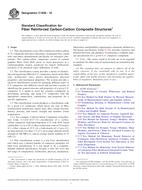Potřebujeme váš souhlas k využití jednotlivých dat, aby se vám mimo jiné mohly ukazovat informace týkající se vašich zájmů. Souhlas udělíte kliknutím na tlačítko „OK“.
ASTM C1836-16
Standard Classification for Fiber Reinforced Carbon-Carbon Composite Structures
Automaticky přeložený název:
Standardní klasifikace pro Fiber Reinforced Carbon Carbon-kompozitní konstrukce
NORMA vydána dne 1.2.2016
Informace o normě:
Označení normy: ASTM C1836-16
Poznámka: NEPLATNÁ
Datum vydání normy: 1.2.2016
Kód zboží: NS-633389
Počet stran: 6
Přibližná hmotnost: 18 g (0.04 liber)
Země: Americká technická norma
Kategorie: Technické normy ASTM
Kategorie - podobné normy:
Anotace textu normy ASTM C1836-16 :
Keywords:
carbon-carbon composites, carbon fiber, classification, graphite, mechanical properties, physical properties,, ICS Number Code 83.120 (Reinforced plastics)
Doplňující informace
| Significance and Use | ||||||||||||||||||||||||||||||||
|
4.1 Composite materials consist by definition of a reinforcement phase/s in a matrix phase/s. The composition and structure of these constituents in the composites are commonly tailored for a specific application with detailed performance requirements. For fiber reinforced carbon-carbon composites the tailoring involves the selection of the reinforcement fibers (composition, properties, morphology, interface coatings etc), the matrix (composition, properties, and morphology), the composite structure (component fractions, reinforcement architecture, interface coatings, porosity structure, microstructure, etc.), and the fabrication conditions (assembly, forming, densification, finishing, etc.). The final engineering properties (physical, mechanical, thermal, electrical, etc) can be tailored across a broad range with major directional anisotropy in the properties. 4.2 This classification system assists the designer/user/producer in identifying and organizing different types of C-C composites (based on fibers, matrix, architecture, physical properties, and mechanical properties) for structural applications. It assists the composites community in developing, selecting, and using C-C composites with the appropriate composition, construction, and properties for a specific application. 4.3 This classification system is a top level identification tool which uses a limited number of composites properties for high level classification. It is not meant to be a complete, detailed material specification, because it does not cover the full range of composition, architecture, physical, mechanical, fabrication, and durability requirements commonly defined in a full design specification. Guide C1783 provides direction and guidance in preparing a complete material specification for a given C-C composite component. |
||||||||||||||||||||||||||||||||
| 1. Scope | ||||||||||||||||||||||||||||||||
|
1.1 This classification covers fiber reinforced carbon-carbon (C-C) composite structures (flat plates, rectangular bars, round rods, and tubes) manufactured specifically for structural components. The carbon-carbon composites consist of carbon/graphite fibers (from PAN, pitch, or rayon precursors) in a carbon/graphite matrix produced by liquid infiltration/pyrolysis or by chemical vapor infiltration, or both. 1.2 The classification system provides a means of identifying and organizing different C-C composites, based on the fiber type, architecture class, matrix densification, physical properties, and mechanical properties. The system provides a top-level identification system for grouping different types of C-C composites into different classes and provides a means of identifying the general structure and properties of a given C-C composite. It is meant to assist the ceramics community in developing, selecting, and using C-C composites with the appropriate composition, construction, and properties for a specific application. 1.3 The classification system produces a classification code for a given C-C composite, which shows the type of fiber, reinforcement architecture, matrix type, fiber volume fraction, density, porosity, and tensile strength and modulus (room temperature). 1.3.1 For example, Carbon-Carbon Composites Classification Code, C3-A2C-4C2*-32—classification of a carbon-carbon composite material/component (C3) with PAN based carbon fiber (1.4 This classification system is a top level identification tool which uses a limited number of composite properties for high level classification. It is not meant to be a complete, detailed material specification, because it does not cover the full range of composition, architecture, physical, mechanical, fabrication, and durability requirements commonly defined in a full design specification. Guide C1783 provides extensive and detailed direction and guidance in preparing a complete material specification for a given C-C composite component. 1.5 Units—The values stated in SI units are to be regarded as standard. No other units of measurement are included in this standard. 1.6 This standard does not purport to address all of the safety concerns, if any, associated with its use. It is the responsibility of the user of this standard to establish appropriate safety and health practices and determine the applicability of regulatory limitations prior to use. |
||||||||||||||||||||||||||||||||
| 2. Referenced Documents | ||||||||||||||||||||||||||||||||
|
Doporučujeme:
Aktualizace technických norem
Chcete mít jistotu, že používáte pouze platné technické normy?
Nabízíme Vám řešení, které Vám zajistí měsíční přehled o aktuálnosti norem, které používáte.
Chcete vědět více informací? Podívejte se na tuto stránku.




 Cookies
Cookies
